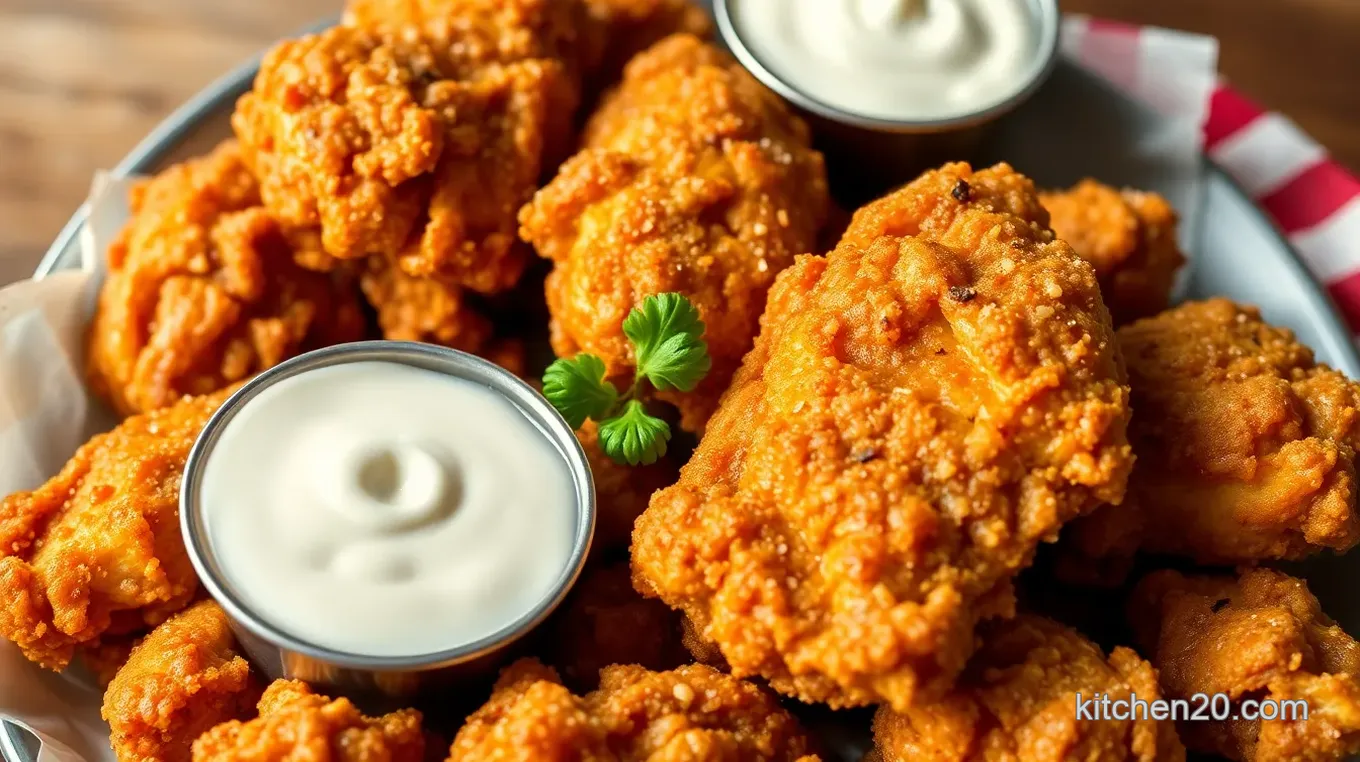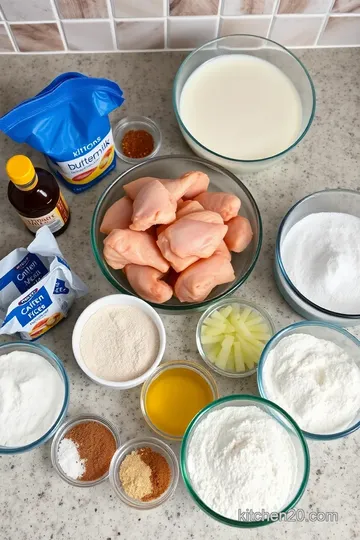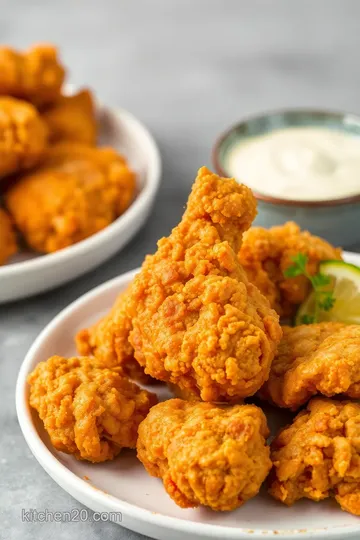Fried Chicken: Deliciously Crispy in 30 Minutes
Craving comfort food? This fried chicken recipe delivers deliciously crispy bites in 30 minutes! Discover my easy tips and enjoy a family favorite.

- A Crispy Southern Comfort You Can’t Resist
- Craving for Crispy Chicken: Recipe Snapshot
- Why You’ll Love This Recipe
- Transitioning to Ingredients
- Essential Ingredients Guide
- Mastering Professional Cooking: The Fried Chicken Edition
- Pro Tips & Secrets for Fried Chicken
- Perfect Presentation: Looks Matter!
- Storage & Make-Ahead: Plan for Success!
- Creative Variations to Spice Things Up
- Complete Nutrition Guide: Know What’s Cooking
- Expert FAQ Solutions: Your Questions Answered
- Conclusion: Get Cooking!
- Recipe Card
A Crispy Southern Comfort You Can’t Resist
I vividly remember the first time i attempted to make fried chicken: deliciously crispy in 30 minutes . i had just moved into my own apartment, and the smell of fried chicken was calling me like a siren song.
I'd seen my grandmother whip it up with ease, but boy, did i underestimate how satisfying it would be to create my own crispy chicken!
So, have you ever craved a meal that feels like a warm hug? fried chicken is that dish for so many of us.
Originating mainly from southern cuisine, it resonates with comfort. a golden brown chicken with a crunchy coating is like a ticket to nostalgia, isn’t it? with just a bit of prep, you can serve up a quick chicken dinner that warms the soul.
Craving for Crispy Chicken: Recipe Snapshot
Fried chicken has a rich history, deeply rooted in southern traditions. it's been a staple for family dinners, especially for gatherings and celebrations.
In today’s fast-paced world, it’s fascinating to see how this classic has made a revival, with trendy variations popping up everywhere.
A homemade fried chicken can take as little as 30 minutes , making it perfect for your busy weeknights.
If you're wondering about the cost, let me tell you, it won't break the bank! you can easily feed a family of four for around $10-15 .
And the yield is impressive—about four servings of juicy chicken that everyone will love.
Why You’ll Love This Recipe
Now, let's talk about the key benefits of this recipe, because who doesn't want delicious food that’s also good for you? fried chicken can be nourishing when prepared right.
The buttermilk marinade not only makes the chicken tender but also adds a delightful tang. plus, it’s high in protein and full of flavor!
This recipe checks all the boxes for special occasions too—think family barbecues or cozy dinners. its quick prep time makes it great for last-minute meals when guests drop by.
Plus, you have room to play with it! go spicy with a little cayenne, add seasonal spices, or create a flavorful chicken coating that becomes your new signature.
And let’s not forget about the dipping sauces —who can resist a spicy honey sauce or a zesty ranch paired with crispy chicken? This dish is the perfect canvas for all your culinary creativity!
Transitioning to Ingredients
Feeling ready to dive into this home-cooked comfort food? let me take you through the list of ingredients you'll need for this crispy chicken recipe.
Get those frying pans ready, because you're just a few steps away from delicious fried chicken variations that your whole family will be begging for!
On to the next section, where I’ll share all the juicy specifics, including tips for that ideal crunchy coating! Get your ingredients list handy because our delicious adventure is about to begin!

Essential Ingredients Guide
Cooking is like crafting a masterpiece, and every great dish starts with quality ingredients. when you’re making fried chicken: deliciously crispy in 30 minutes , nailing down the essentials can mean the difference between a tasty dinner and a total flop.
Let's break it down!
Premium Core Components
First off, knowing the exact measurements can supercharge your cooking game. for our fried chicken, you’ll need 4 large bone-in, skin-on chicken pieces (around 2 pounds / 900 grams ).
You might wanna get a kitchen scale for those metric cooks! a cup is 240 milliliters for the buttermilk, while your flour should come in at 120 grams .
Quality indicators matter too. look for juicy chicken with a bit of bounce when you poke it. fresh buttermilk should smell slightly tangy, not sour.
And for the flour? it should be fine and free from lumps.
When it comes to storage , keep the chicken in the fridge if you're not using it right away, and use it within 1-2 days.
Shelf life for the buttermilk? about two weeks—just check that expiration date!
Want to keep it fresh? Always check for signs of spoilage before you cook. If it smells funky or has changed color, throw it out!
Signature Seasoning Blend
Let’s spice things up! The key to the perfect crispy chicken recipe lies in the signature seasoning blend . Here’s a classic mix to get you started:
- 1 teaspoon paprika
- 1 teaspoon garlic powder
- 1 teaspoon onion powder
- 1 teaspoon salt
- ½ teaspoon black pepper
- ½ teaspoon cayenne pepper (or more, if you like a kick!)
Remember, flavor is all about balance! you might switch it up by tossing in some dried oregano or thyme for that extra herbal touch.
This is where the magic happens, turning your basic chicken into home-cooked comfort food .
Smart Substitutions
Life happens, and sometimes, you run out of an ingredient. No biggie! Here are some common alternatives to keep in your back pocket:
If you don't have buttermilk , a quick hack is to mix regular milk with a splash of vinegar or lemon juice. Voilà, instant buttermilk!
For the flour, if you need a gluten-free option, try almond flour or a gluten-free mix. they work surprisingly well in frying—just don’t forget to adjust your spices to complement the nutty flavor.
In a pinch? Swap out the hot sauce with some chili powder for that spicy fried chicken profile!
Kitchen Equipment Essentials
You don’t need a fancy kitchen to whip up Fried Chicken. Here’s a list of must-have tools to make your cooking a breeze:
- Large bowl for marinating
- Shallow dish for the coating
- Large heavy-bottomed skillet or deep fryer for that high-heat frying
- Tongs to handle the chicken safely
- Paper towels to soak up the oil afterward
If you don’t have a heavy skillet, any thick-bottomed pan will do. And for those who aren't into frying, an air fryer can still give you that satisfying, golden brown chicken with a lot less oil!
Wrapping It Up
Now that we’ve covered the essentials, you're all set to create some delicious fried chicken variations ! these tips will help pave the way for a quick chicken dinner that your family will rave about.
Just imagine biting into that crispy chicken , seasoned to perfection, while you gather 'round the table with your crew.
Ready to get frying? let me guide you through the step-by-step instructions for cooking that fried chicken: deliciously crispy in 30 minutes ! trust me; you’re going to want to dive in headfirst into this mouthwatering goodness.
Get your apron on, and let’s turn up that heat!
Mastering Professional Cooking: The Fried Chicken Edition
Oh, fried chicken! is there anything better than the crunch of that perfectly crispy coating? i mean, who can resist the allure of southern fried chicken ? this crispy chicken recipe will take you from “i’m starving” to “dinnertime” in just 30 minutes .
But before we dive into that, let’s get to the heart of professional cooking methods so you can whip up this classic comfort food like a pro!
Essential Preparation Steps
First things first: mise en place ! it's a fancy term for having everything organized and ready to go. before you even think about frying, gather all your ingredients—chicken, buttermilk, and those killer spices—so you aren’t running around like a headless chicken (pun intended).
Time management is key here. if you plan to marinate your chicken (and you really should), think about that time in advance.
You can start preparing during that 15-minute active prep time while your chicken soaks in that lovely buttermilk marinade. organization strategies like having your coating mixture prepped and your frying station ready will save you a panic in the kitchen.
Oh, and please don’t forget about safety considerations : keep a thermometer handy to make sure your oil gets to 350° f ( 175° c) —too hot and you'll burn it, too cold and it'll just taste greasy.
Step-by-Step Process
Alright, here’s how to make Fried Chicken: Deliciously Crispy in 30 Minutes :
-
Marinate Chicken:
- Whisk up 1 cup of buttermilk and a splash of hot sauce (if you're feeling adventurous!). Dunk those chicken pieces in there and get them coated. Let them chill for 15- 30 minutes. The longer, the better!
-
Prepare Coating:
- In a shallow dish, mix 1 cup of flour with all your starred spices. That’s paprika, garlic powder, onion powder, salt, black pepper, and cayenne. Seriously, this is your flavor bomb!
-
Heat Oil:
- Pour about 3 cups of vegetable oil into a large skillet. Heat over medium-high until it's sizzling at 350° F ( 175° C) . Pro tip: toss a tiny piece of bread in there; if it sizzles, you’re good to go!
-
Coat Chicken:
- Take each chicken piece from the marinade, let the excess drip off, and roll it in your flour mix. Press it in there! We want the crunchy chicken coating to stick.
-
Fry Chicken:
- Gently place your chicken in the hot oil. Here’s where the magic happens. Fry them for 8- 10 minutes , turning them occasionally, until they are golden brown at 165° F ( 75° C) internal temp.
-
Drain and Rest:
- Once golden brown, remove your masterpiece and let it rest on paper towels. This keeps it crisp and absorbs excess oil.
Expert Techniques
Now that you've got the basics down, let’s get a bit more technical. one critical step is temperature control. keep an eye on that oil—too hot can mean burnt skin, while too cool leads to soggy sadness.
Always aim for a crispy skin and juicy meat.
Quality checkpoints? Check that internal temp with a meat thermometer. Remember, no chicken should be undercooked!
If things don’t seem to be going right—maybe the chicken is burning or undercooking—don't panic! It’s normal. Adjust your oil temperature as needed.
Success Strategies
Okay, let’s chat about some common mistakes to avoid. First, don't skip the marinating step! It’s essential for that luscious flavor, especially if you’re using a buttermilk marinade .
Next, if you’re frying in batches, be patient! fry in small amounts to avoid overcrowding the pan. you want that hot oil to work its magic on each piece, making sure golden brown chicken all around.
And here’s a little insider tip: Let your breaded chicken sit for a couple of minutes before frying; it helps that crunchy coating stick better!
Wrapping It Up
So, there you have it! You’ve equipped yourself with the knowledge to create delicious fried chicken that’s sure to become the star of your family dinner table! Pair it up with some classic sides like coleslaw or cornbread and you’ve got yourself a feast!
Next up, i’ll share some additional information about how to make this dish uniquely yours with flavor variations and tips on serving up the best dipping sauces to accompany your homemade fried chicken .
Trust me, it’s going to be finger-lickin’ good!

Pro Tips & Secrets for Fried Chicken
Oh my gosh, if you want to kick your fried chicken: deliciously crispy in 30 minutes up a notch, listen up! i’ve got some insider secrets for you.
First off, when marinating your chicken in that buttermilk , consider tossing in a splash of hot sauce. it'll give your marinated fried chicken a nice kick without being overly spicy.
Plus, the acid helps tenderize the meat even more.
Now, let’s talk efficiency. if you're pressed for time, consider breading and frying smaller chicken pieces like drumsticks and wings .
They cook faster, so you can have a quick chicken dinner ready in no time! and hey, to really boost those flavors, let your fried chicken rest after frying.
It allows any extra oil to drip off, leaving you with perfectly crispy skin and juicy meat. win-win!
Perfect Presentation: Looks Matter!
You know what they say: we eat with our eyes first! when it comes to presentation, don’t skimp out. try stacking your golden brown chicken on a rustic wooden board for that homey feel.
You could also add some color by throwing in a pop of freshness with a sprinkle of chopped parsley or even some lemon wedges.
Talk about visual appeal!
Don’t forget about plate choice! using a vibrant plate can enhance your dish’s presentation. and let’s not overlook the best dipping sauces .
A little ramekin of spicy aioli or tangy ranch not only adds flavor but also a nice touch to your table.
Storage & Make-Ahead: Plan for Success!
Got leftovers? no worries! let your crispy chicken cool down, then store it in an airtight container in the fridge.
Honestly, it should last about 3-4 days. if you want it to stay extra fresh, you can wrap it tightly in foil before popping it in the fridge.
Reheating can be tricky. you want that skin to stay crunchy, right? so, if you can, heat it in the oven at 375° f ( 190° c) until it's warmed through—about 10– 15 minutes should do the trick.
Avoid the microwave unless you want soggy skin (no thanks!).
Creative Variations to Spice Things Up
The beauty of fried chicken is that it's super versatile. want to jazz it up? try swapping the spices in your flour mixture .
How about some seasonal spices for chicken ? think sage for fall or zesty lemon pepper during the summer.
Feeling adventurous? why not go for spicy fried chicken ? just add more cayenne or even a bit of chili powder to your coating mix.
If you're trying to keep it healthier, replace plain flour with almond flour to make a gluten-free version. you can really play around with it!
Complete Nutrition Guide: Know What’s Cooking
Understanding what you’re serving is key, especially for a dish like fried chicken. this recipe packs around 400 calories per serving, with about 25g of protein —not too shabby for some home-cooked comfort food ! if you’re keeping an eye on sodium, just remember that adding extra salt can change things quite a bit, so adjust according to your taste.
You might be tempted to consider fried chicken a guilty pleasure, but it doesn’t have to be! with the right sides—think green salads or steamed veggies—you can balance your plate quite well.
Portioning also plays a crucial role here. keep those portions in check if you want to enjoy delicious fried chicken variations without overdoing it!
Expert FAQ Solutions: Your Questions Answered
Let’s hit a few common questions. a lot of folks wonder why their chicken frying didn’t turn out crispy. if that's you, check if your oil’s hot enough.
You want it around 350° f . if it’s not hot enough, the coating will soak up oil and turn soggy.
Another popular query: how to keep that crispy skin while storing? just make sure it’s completely cool before sealing it up.
And always, always drain excess oil on a paper towel after frying for that crunchy coating !
Conclusion: Get Cooking!
So, there you have it! with these tips, your fried chicken will not only be deliciously crispy in 30 minutes , but it’ll also look good and taste even better! look into into those flavors, enjoy the process, and make it your own! cooking should be fun, so add your twist and make this dish a family favorite.
Grab your loved ones, get frying, and make some unforgettable memories. happy cooking, friends!

Fried Chicken: Deliciously Crispy in 30 Minutes Card

⚖️ Ingredients:
- 4 large bone-in, skin-on chicken pieces (about 2 pounds / 900 grams)
- 1 cup buttermilk (240 ml)
- 1 teaspoon hot sauce (optional)
- 1 cup all-purpose flour (120 grams)
- 1 teaspoon paprika
- 1 teaspoon garlic powder
- 1 teaspoon onion powder
- 1 teaspoon salt
- ½ teaspoon black pepper
- ½ teaspoon cayenne pepper (adjust to taste)
- Vegetable oil (for frying, about 3 cups / 720 ml)
🥄 Instructions:
- Step 1: In a large bowl, whisk together buttermilk and hot sauce (if using). Add chicken pieces, coating them well. Cover and refrigerate for 15-30 minutes.
- Step 2: In a shallow dish, combine flour, paprika, garlic powder, onion powder, salt, black pepper, and cayenne pepper.
- Step 3: In a large skillet or deep fryer, heat vegetable oil over medium-high heat until it reaches 350°F (175°C).
- Step 4: Remove chicken from the marinade, letting excess drip off. Dredge each piece in the flour mixture, pressing to adhere, and shake off excess.
- Step 5: Carefully place chicken pieces into the hot oil, being cautious of splatter. Fry for about 8-10 minutes, turning occasionally until golden brown and the internal temperature reaches 165°F (75°C).
- Step 6: Remove chicken from the oil and transfer to a paper towel-lined plate to drain excess oil.
Previous Recipe: Easy Grilled Chicken Salad - Fresh & Healthy Delight for Summer Days!
Next Recipe: How to Make Fried Chicken Parmesan - Deliciously Crispy Comfort
